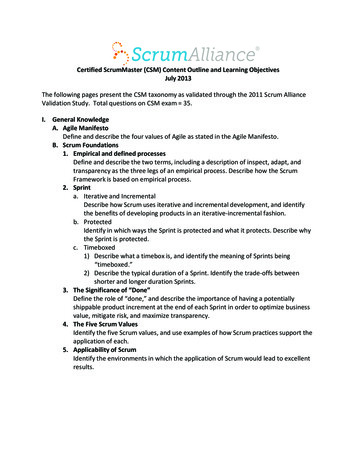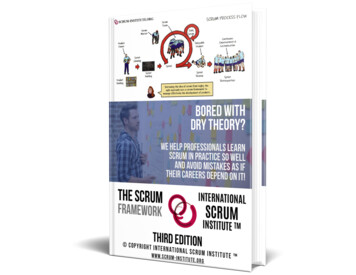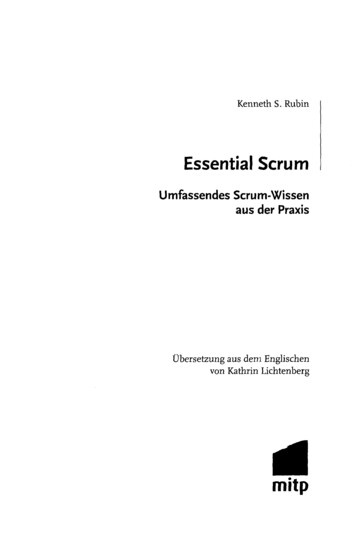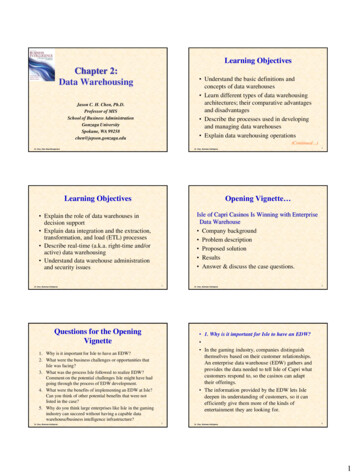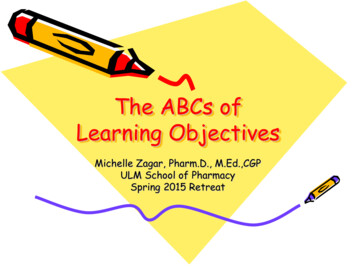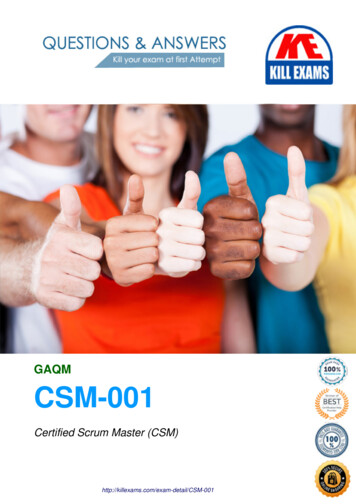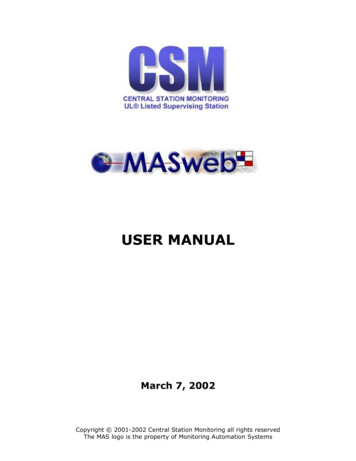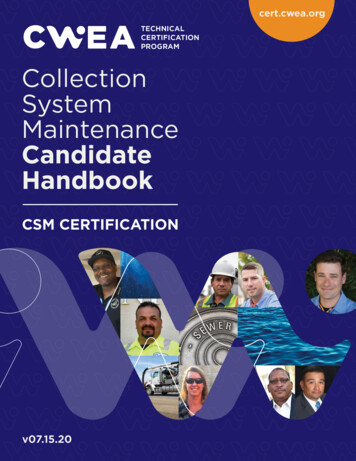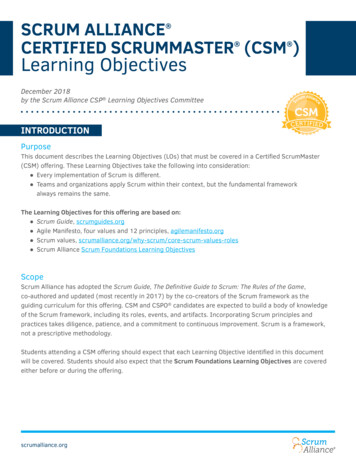
Transcription
1SCRUM ALLIANCECERTIFIED SCRUMMASTER (CSM ) Learning ObjectivesDecember 2018by the Scrum Alliance CSP Learning Objectives CommitteeINTRODUCTIONPurposeThis document describes the Learning Objectives (LOs) that must be covered in a Certified ScrumMaster(CSM) offering. These Learning Objectives take the following into consideration: Every implementation of Scrum is different. Teams and organizations apply Scrum within their context, but the fundamental frameworkalways remains the same.The Learning Objectives for this offering are based on: Scrum Guide, scrumguides.org Agile Manifesto, four values and 12 principles, agilemanifesto.org Scrum values, s Scrum Alliance Scrum Foundations Learning ObjectivesScopeScrum Alliance has adopted the Scrum Guide, The Definitive Guide to Scrum: The Rules of the Game,co-authored and updated (most recently in 2017) by the co-creators of the Scrum framework as theguiding curriculum for this offering. CSM and CSPO candidates are expected to build a body of knowledgeof the Scrum framework, including its roles, events, and artifacts. Incorporating Scrum principles andpractices takes diligence, patience, and a commitment to continuous improvement. Scrum is a framework,not a prescriptive methodology.Students attending a CSM offering should expect that each Learning Objective identified in this documentwill be covered. Students should also expect that the Scrum Foundations Learning Objectives are coveredeither before or during the offering.scrumalliance.org
2The CSM Learning Objectives fall into the following categories:1. Lean, Agile, and Scrum2. Scrum Master Core Competencies3. Service to the Development Team4. Service to the Product Owner5. Service to the OrganizationIndividual trainers (CSTs) or coaches (CECs and CTCs) may choose to teach ancillary topics. Ancillarytopics presented in a CSM offering must be clearly indicated as such.LEARNING OBJECTIVESA note about Bloom’s Taxonomy:While some Learning Objectives appear to tell a trainer or coach how to teach, that is not the intent.Bloom’s-style Learning Objectives describe what the learner can do upon completing the class.Instead of including the words, please mentally start each Learning Objective with the following phrase:“Upon successful validation of the CSM Learning Objectives, the learner will be able to ”This Bloom’s style of Learning Objectives consists of six levels of SynthesisEvaluationThe levels progress from lower order to higher order thinking skills, Knowledge( ) through Evaluation(The level of each learning objective can be identified using the image designations above.1. Lean, Agile, and Scrum).Scrum Theory1.1. describe how the values of Scrum — focus, courage, commitment, openness, and respect —are present in a specific Scrum event, artifact, or role.Scrum Roles1.2. list at least three rights and five responsibilities of the Product Owner, Development Teamand Scrum Master.1.3. discuss at least two reasons why the Product Owner is a single person and not a group ora sSynthesisEvaluation
31.4. discuss how and why the Product Owner maintains authority over the product while workingcollaboratively with the Development Team and stakeholders to gather their ideas, feedback,and input.1.5. list at least five characteristics of the Development Team.1.6. identify at least three negative consequences that arise when the Development Team consistsof fewer than three or more than nine people.1.7. state at least two reasons why no one can force the Development Team to work from a differentset of requirements than the Product Owner’s.Scrum Events and Artifact Transparency1.8. give one example of how a Scrum Team will inspect and adapt and increase transparency ateach of the Scrum events.1.9. describe at least three responsibilities for the Development Team, Product Owner, and ScrumMaster during Sprint Planning, Daily Scrum, Sprint Review, and Retrospective.Sprint and Increment1.10. describe at least two reasons why the Sprint goal does not change during a Sprint.1.11. define the outcome of every Sprint and describe at least three reasons why that is important.1.12. discuss at least three reasons why the Increment must be brought to the current definitionof “Done” regardless of whether the Product Owner chooses to release the Increment.Sprint Planning1.13. discuss the focus of the activities of the Product Owner and Development Team duringthe two topics of Sprint Planning: the “What” and the “How.”1.14. practice writing a Sprint Goal and identify at least two benefits of having a Sprint Goal.Daily Scrum1.15. discuss at least three ways the Daily Scrum differs from a status meeting and why thevarious constraints exist to support the Development Team.1.16. identify at least three possible structures the Development Team could use to runthe Daily Scrum within the time-box.Sprint Review1.17. describe at least three of the activities that take place during the Sprint Review thatpertain to work beyond what has been completed in the Sprint,1.18. identify at least three potential outcomes for a Sprint Review.Sprint Retrospective1.19. explain at least three distinct responsibilities for the Scrum Master during theSprint lysisSynthesisEvaluation
4Product Backlog1.20. describe at least two responsibilities of the Development Team, Product Owner,and Scrum Master in the development and maintenance of the Product Backlog.1.21. identify at least three essential characteristics of the Product Backlog.1.22. list at least four attributes of a Product Backlog item.Sprint Backlog1.23. identify at least three essential characteristics of the Sprint Backlog.1.24. explain how the Sprint Backlog can be changed, who can make changes,and the limits of these changes.Definition of “Done”1.25. identify at least two reasons why multiple teams working on the same Product Backlogmust have a shared and consistent definition of “Done.”1.26. describe at least three opportunities where the Scrum Team might adapt their definitionof “Done” to meet new insights or circumstances.1.27. explain the importance of a strong definition of “Done” and describe at least two risksassociated with a weaker definition of “Done.”1.28. outline at least one way to create a definition of “Done.”2. Scrum Master Core CompetenciesFacilitation2.1. list at least three ways the Scrum Master could facilitate for the Scrum Team.2.2. demonstrate at least three techniques for facilitating group decision making.Coaching2.3. state a distinction among facilitating, teaching, mentoring, and coaching.2.4. list at least three different challenges facing a self-organizing team.2.5. practice the implementation of at least one Retrospective technique that could helpto resolve a challenge faced by a self-organizing team.3. Service to the Development TeamScrum Master as Servant-Leader3.1. define servant-leadership3.2. describe three scenarios where the Scrum Master acts as the servant-leader forthe Development Team.3.3. discuss at least one scenario in which the Scrum Master, acting as a servant-leader,improved at least one aspect of the Development Team.3.4. identify possible violations of Scrum by a Product Owner or stakeholder who is applyingexcessive time pressure and illustrate how to address hesisEvaluation
5Value of Development Practices3.5. define technical debt and explain the impact of accumulating technical debt.3.6. list at least five development practices that will help Scrum Teams deliver a high-qualityproduct Increment and reduce technical debt each Sprint.3.7. list at least three ways development practices may impact the Development Team’sability to deliver a potentially releasable Increment each Sprint.4. Service to the Product Owner4.1. identify at least three collaboration techniques that a Product Owner can use to workwith the Development Team or stakeholders.4.2. explain at least three ways the Scrum Master could support the Product Owner.5. Service to the OrganizationImpediment Removal5.1. discuss at least two ways that the Scrum Master assists the Scrum Team with respondingto impediments.5.2. discuss at least three common organizational impediments outside the scope of a teamthat can affect the effectiveness of Scrum Teams.Coaching the Organization5.3. describe at least one example of a major organizational design change implied byimplementing Scrum.5.4. discuss why Scrum does not have a project manager and what happens to traditionalproject management activities.5.5. describe at least two stakeholder behaviors that support the Scrum Team’s successand at least two behaviors that do not support the Scrum Team’s success.5.6. describe at least two benefits that could be lost if Scrum is only partially sisSynthesisEvaluation
6PROGRAM TEAMSStrengthening our Certifications:Path to CSPSM Karim Harbott Erika Massie Carlton Nettleton Lisa Reeder Jason Tanner Andreas SchliepSupported by Scrum Alliance Staff: Shannon Larsen Cody nthesisEvaluation
3.2. describe three scenarios where the Scrum Master acts as the servant-leader for the Development Team. 3.3. discuss at least one scenario in which the Scrum Master, acting as a servant-leader, improved at least one aspect of the Development Team. 3.4. identify possible violations of Scrum by a Product Owner or stakeholder who is applying excessive time pressure and illustrate how to address .
